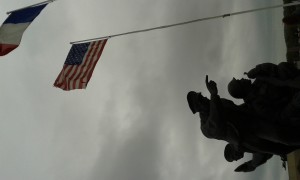You can read about the struggles of the soldiers storming the beaches. You can read about the strategic struggles that a grand amphibious invasion on that scale was for the Allied forces. You can read about how the Nazis dug in and held Europe within their clutches and defended the beachheads with their lives, machine guns and bunkers. But until seeing it firsthand, you cannot comprehend what destruction, chaos and bloodshed both sides faced on June 6th, 1944. D-Day, the greatest and largest amphibious invasion ever, named Operation Overlord by the Allied forces, was the simultaneous invasion of Normandy by Britain, the USA, Canada and other Allied nations against the Nazi Regime. When visiting Bayeux, France, you get the feel for a small town that is very peaceful and happy. It is a quaint little town that enjoys football, pastries, and good company for conversations. Yet around 70 years ago, it was under siege by the Nazis and liberation by the Allies. During our time in the Normandy region of France, we visited three of the five main beaches that the Allies invaded during D-Day and the sights were astonishing. After visiting Utah, Omaha and Gold Beaches, my comprehension of World War II knowledge and life was changed forever.
First looking at the most successful of the five beaches, Utah Beach was our first stop, and during high tide and speedy winds, it was very wet and sandy. After collecting your thoughts and some sand in a glass jar, you walked into the museum which helped tell the narrative. Operation Neptune, the preliminary paratrooper mission that took out most of the main Nazi artillery in the Cherbourg Peninsula near Utah Beach, was the main reason Utah Beach was a success. Even though the Allies fought against tough Nazi bunkers and machine gun fire, the casualties were fewer than expected. Yet the success of Utah was the polar opposite of what happened at Omaha.
The memorial at Omaha and the solemnity that existed in the waves at this beach were indescribable. The landings themselves were off the original path, the German resistance was toughest here, and the death count was high for the Allied forces. Even though there was an eventual success at all five beaches, Omaha was definitely the one that cost the most lives at such high risk. Walking along the coastline and imaging the dead bodies of the fallen Allied forces is just heart wrenching. It is a part of history and a cost of war, but from the ashes of the dead soldiers came new life for freedom and peace once the Allies defeated Hitler and the Germans by conquering Berlin.
The final beach we visited was my specific site report on the trip: Gold Beach and Arromanches, a small French commune turned artificial harbor. From here, the Allies, specifically Britain, made their supply drops, movement of people and materials across the English Channel and was a vital strategic location for the Allies to continue to have reinforcements while moving inland towards more fortified German positions. Being able to see what I was researching and talking about was mesmerizing, and to imagine the amount of men and material that went through the harbor and the town many years ago was incredible. Bayeux itself and the region around it has so much history of the Second World War and was fantastic to visit! 

